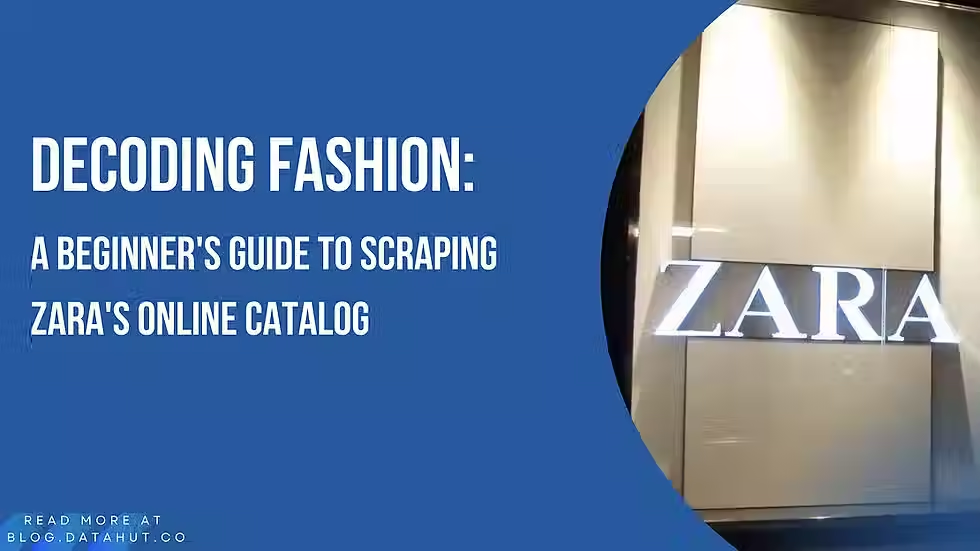What Fashion Retailers Can Learn from Zara’s Pricing Strategy
- Aarathi J
- Jul 31
- 3 min read

Introduction
Zara’s pricing strategy is a benchmark in fast fashion retail. Known for combining trend responsiveness with smart pricing, Zara balances affordable fashion with premium appeal. Through data-driven pricing, the brand adjusts product costs by region, fabric type, and category—while maintaining brand value through minimal discounting.
In this blog, we explore Zara’s pricing insights, backed by web scraping techniques and product-level data analysis, to uncover what fashion retailers can learn and implement in their own pricing strategies.
👉 Looking for an in-depth breakdown with detailed visuals and statistics? Check out our full analysis of Zara’s pricing strategy here.
Strategic Takeaways from Zara’s Pricing Strategy
1. Affordable Meets Premium: A Balanced Price Range
Zara's prices span from ₹490 to ₹15,590, but most items cluster under ₹6,000. This lets the brand cater to both budget shoppers and aspirational buyers.
Real-World Parallel: Like H&M’s ₹299–₹29,999 strategy, Zara uses a pricing pyramid: basics at the base, statement pieces at the top.
Retailer Tip: Offer accessible price anchors with a few premium SKUs to elevate brand perception.
2. Localized Pricing for Global Relevance
Zara adjusts average product prices by region—e.g., higher in Myanmar and India, lower in Portugal.
Retailer Insight: Uniqlo follows a similar path with region-specific pricing that factors in import costs and brand perception.
Retailer Tip: Use web scraping and market data to optimize region-specific pricing
3. Material and Quality Drive Pricing
Sheep leather and silk items top Zara’s price list, while cotton and polyester dominate the mid-range.
Real-World Scenario: H&M Conscious collection uses this model—eco fabrics cost more but cater to a niche, quality-focused audience.
Retailer Tip: Price according to perceived fabric value. Upsell premium materials through storytelling
4. Category-Based Pricing Anchors
Coats and blazers are high-ticket items, while tops and accessories are entry points.
Retailer Parallel: Mango and Massimo Dutti (Inditex siblings) use similar pricing anchors—luxury outerwear, accessible separates.
Retailer Tip: Let premium outerwear offset margin losses on fast-moving essentials.
5. Discounts Done Sparingly
Only 3.1% of Zara products are discounted—most between 40–50%. It uses discounts to move inventory, not to drive regular traffic.
Compare With: Brands like Forever 21 rely on constant markdowns, diluting brand value. Zara preserves its premium perception.
Retailer Tip: Don’t over-discount. Use markdowns as strategic inventory levers—not customer expectations.
👉The pricing insights shared here were powered by structured web scraping and analysis. Check out our step-by-step guide to scraping Zara’s catalog: Decoding Fashion – Beginner’s Guide
Challenges & Opportunities in Fashion Pricing
Challenges
Global Price Sensitivity: Uniform pricing can cause friction in price-sensitive markets.
Fast Trend Cycles: Overpricing rapidly outdated items can lead to unsold stock.
Supply Chain Volatility: Costs of premium materials (like silk/leather) can fluctuate with global events.
Opportunities
Dynamic Pricing Models: Using AI to adjust prices in real time (Zara is already doing this).
Ethical Pricing Strategies: Premium sustainability-focused collections are increasingly acceptable at higher price points.
Data-Driven Markdown Planning: Limit discounts to low-performing items based on live data, preserving brand equity.
Conclusion
Zara proves that pricing isn’t just a finance decision—it’s a brand strategy. From category anchoring to disciplined discounting, its pricing helps drive both profit and perception. Retailers who embrace smart pricing, powered by real-time data, can stand out in a crowded market.
To explore the complete dataset, box plot and histogram analyses, and global material trends, read the full Zara pricing analysis blog.
Want to replicate Zara’s pricing success using data?
Talk to Datahut — we help fashion retailers harness web scraping and pricing analytics to stay ahead of the curve.
FAQ SECTION
What makes Zara’s pricing strategy so effective?
Zara combines affordability with aspirational value by offering a wide price range, minimal discounts, and region-specific pricing—all backed by real-time data. Explore Zara’s full pricing insights!
How does Zara use data to determine prices?
Zara leverages product-level data and market trends to adjust prices by category, fabric, and region. Read our Beginner’s Guide to Scraping Zara’s Catalog for a behind-the-scenes look.
Should fashion retailers always avoid discounts like Zara?
Not necessarily. Zara uses discounts strategically to clear stock, while other brands may rely on heavy markdowns. Learn why strategic discounting helps maintain brand value.
How can other retailers implement Zara’s pricing model?
Retailers can analyze competitors’ prices using web scraping tools, then apply dynamic pricing and premium positioning tactics. Talk to Datahut for custom data solutions.
Why is localized pricing important in fashion retail?
Pricing based on regional demand and costs helps align with local markets—Zara practices this successfully. See how H&M and Uniqlo approach it too.




